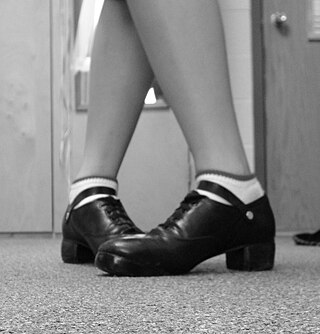
The reel is a folk dance type as well as the accompanying dance tune type. Of Scottish origin, reels are also an important part of the repertoire of the fiddle traditions of Britain, Ireland and North America. In Scottish country dancing, the reel is one of the four traditional dances, the others being the jig, the strathspey and the waltz, and is also the name of a dance figure.

The jig is a form of lively folk dance in compound metre, as well as the accompanying dance tune. It first gained popularity in 16th-century England, Ireland, Scotland, and other parts of the British Isles, and was adopted on mainland Europe where it eventually became the final movement of the mature Baroque dance suite. Today it is most associated with Irish dance music, Scottish country dance and the Métis people in Canada. Jigs were originally in quadruple compound metre,, but have been adapted to a variety of time signatures, by which they are often classified into groups, including double jigs, slip jigs and single jigs.

Irish dance refers to a group of traditional dance forms that originate in Ireland, encompassing dancing both solo and in groups, and dancing for social, competitive, and performance purposes. Irish dance in its current form developed from various influences such as earlier native Irish dance, English country dancing and later possibly French quadrilles, as it became popular in Britain and Ireland during the 19th century. Dance was taught by "travelling dance masters" across Ireland in the 17th and 18th centuries, and separate dance forms developed according to regional practice and differing purposes. Irish dance became a significant part of Irish culture, particularly for Irish nationalist movements. From the early 20th century, a number of organisations promoted and codified the various forms of dance, creating competitive structures and standardised styles. Irish dancers who compete for competitive reasons dance in a dance style that is more modern than traditional Irish dance. It is mainly done solo, but there is some team dancing in groups of 2, 3, 4, 6, 8, 10, 16 and even numbers onwards.

Scottish country dance (SCD) is the distinctively Scottish form of country dance, itself a form of social dance involving groups of couples of dancers tracing progressive patterns. A dance consists of a sequence of figures. These dances are set to musical forms which come from the Gaelic tradition of Highland Scotland, as do the steps used in performing the dances. Traditionally a figure corresponds to an eight-bar phrase of music.

Country–western dance encompasses any of the dance forms or styles which are typically danced to country-western music, and which are stylistically associated with American country and/or western traditions. Many are descended from dances brought to the United States by immigrants from the United Kingdom and Europe as early as the 1700s, which became integrated into American popular culture. Country dancing is also known as "kicker dancing" in Texas.

A cèilidh or céilí is a traditional Scottish and Irish social gathering. In its most basic form, it simply means a social visit. In contemporary usage, it usually involves dancing and playing Gaelic folk music, either at a home or a larger concert at a social hall or other community gathering place.

The hornpipe is any of several dance forms played and danced in Britain and Ireland and elsewhere from the 16th century until the present day. The earliest references to hornpipes are from England, with Hugh Aston's Hornepype of 1522 and others referring to Lancashire hornpipes in 1609 and 1613.
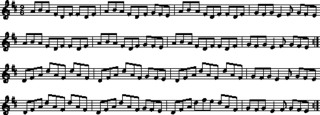
Slip jig refers to both a style within Irish music, and the Irish dance to music in slip-jig time. The slip jig is in 9
8 time, traditionally with accents on 5 of the 9 beats — two pairs of crotchet/quaver followed by a dotted crotchet note.
A strathspey is a type of dance tune in 4
4 time, featuring dotted rhythms, which in traditional playing are generally somewhat exaggerated rhythmically. Examples of strathspeys are the songs "The Bonnie Banks o' Loch Lomond" and "Coming Through the Rye".

Cape Breton fiddling is a regional violin style which falls within the Celtic music idiom. Cape Breton Island's fiddle music was brought to North America by Scottish immigrants during the Highland Clearances. These Scottish immigrants were primarily from Gaelic-speaking regions in the Scottish Highlands and the Outer Hebrides. Although fiddling has changed considerably since this time in Scotland, it is widely held that the tradition of Scottish fiddle music has been better preserved in Cape Breton.

Irish stepdance is a style of performance dance with its roots in traditional Irish dance. It is generally characterized by a stiff upper body and fast and precise movements of the feet. It can be performed solo or in groups. Aside from public dance performances, there are also stepdance competitions all over the world. These competitions are often called Feiseanna. In Irish dance culture, a Feis is a traditional Gaelic arts and culture festival. Costumes are considered important for stage presence in competition and performance Irish stepdance. In many cases, costumes are sold at high prices and can even be custom made. Each costume is different, with varying colors and patterns, designed to attract the judge's eye in competitions and the audience's eye in performance. General appearance beside the costume is also equally important. Female dancers would typically curl their hair before each competition or wear curled wigs, while male dancers would neatly style their hair to a shape to their liking. Poodle Socks are worn by female dancers while males wear plain black socks. Poodle socks are white socks that stretch to typically 1-4 inches above the ankle, depending on the dancers preference. They also have distinctive ribbing, and can be embroidered with gems.
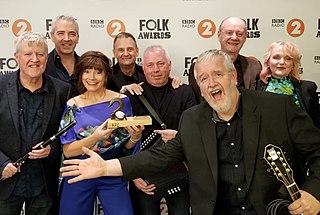
Dervish is an Irish traditional music group from County Sligo, Ireland which has been described by BBC Radio 3 as "an icon of Irish music". They were formed in 1989 by Liam Kelly, Shane Mitchell, Martin McGinley, Brian McDonagh, and Michael Holmes and have been fronted by singer Cathy Jordan since 1991. They represented Ireland in the final of the Eurovision Song Contest 2007, singing a song written by John Waters and Tommy Moran. In 2019 they released an album on the US Rounder Records label called The Great Irish Song Book featuring a selection of classic Irish songs sung by a number of well known singers including Steve Earle, Andrea Corr, Vince Gill, Kate Rusby, Imelda May, Rhiannon Giddens, The Steel Drivers, Brendan Gleeson, Abigail Washburn, and Jamey Johnson. In 2019 they received a lifetime achievement award from the BBC.
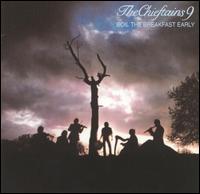
The Chieftains 9: Boil the Breakfast Early is an Irish folk album by The Chieftains. This album featured a big change in The Chieftains sound, because two of the founding members, Seán Potts and Michael Tubridy, had left the group. The replacement for Tubridy was Matt Molloy, who had just been a member for both The Bothy Band and Planxty.
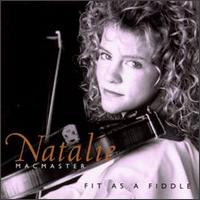
Fit as a Fiddle is an album by Natalie MacMaster. It was reissued by Rounder Records in 1997.
'Shaskeen' is a musical group, based in Ireland, which performs Irish traditional music & song. It was formed in London UK in May 1970 and was still performing and recording as of 2020. Shaskeen Traditional Band is still performing as of 2020 and are at present performing concerts throughout Ireland. The band celebrate 40 years on the road in 2010. Check out "40 Bliain Faoi Bhláth" on TG4 Album no 15 released in 2010 called "Walking Up Town" The band is now Celebrating 50 Years of Tradition as of 2020
From 1770 to 1772 a man called William Vickers made a manuscript collection of dance tunes, of which some 580 survive, including both pipe and fiddle tunes. The manuscript is incomplete - 31 pages have not survived, though their contents are listed at the beginning of the book. In the mid-19th century, it belonged to the pipemaker John Baty, of Wark, Northumberland, and it now belongs to the Society of Antiquaries of Newcastle upon Tyne. It is kept in the Northumberland County Record Office at Woodhorn, Ashington.
Métis fiddle is the style that the Métis of Canada and Métis in the northern United States have developed to play the violin, solo and in folk ensembles. It is marked by the percussive use of the bow and percussive accompaniment. The Metis people are a poly-ethnic post-contact Indigenous peoples. Fiddles were "introduced in this area by Scottish and French-Canadian fur traders in the early 1800s", where the Metis community adopted the instrument into their culture.

Muriel Johnstone is a Scottish pianist and composer. She was raised and schooled in Ardrossan, Ayrshire, Scotland.













